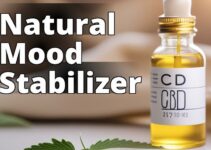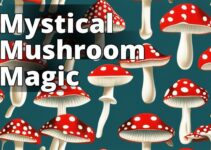What readers will learn from this article:
- Readers will learn about the features and hallucinogenic properties of Amanita muscaria, including the detoxification process.
- Readers will learn about the recent scientific discovery of the biosynthetic pathway of ibotenic acid and muscimol in Amanita muscaria.
- Readers will learn about the increasing popularity of Amanita muscaria as a legal substitute for psychedelic mushrooms, its psychoactive compound, and consumption methods.
Understanding Amanita Muscaria
Amanita muscaria, commonly known as the fly agaric mushroom, is a distinctive and fascinating species found in temperate and boreal regions of the Northern Hemisphere. Recognizable by its iconic red cap adorned with white spots, this mushroom possesses powerful hallucinogenic properties that have captivated humans for centuries.
The fly agaric contains two main toxins: muscimol and ibotenic acid. These compounds are responsible for the psychoactive effects induced by Amanita muscaria, such as vivid hallucinations, altered perception of reality, and even a sense of spiritual awakening. It is important to note that the effects can vary greatly depending on the individual and the dosage consumed.
While fatal cases of Amanita muscaria poisoning are rare, caution should always be exercised when handling or consuming this mushroom. To reduce the risk of toxicity, it is recommended to boil the mushroom before consumption. Boiling helps detoxify the mushroom by breaking down the toxins, making it safer to consume.
Uncovering the Biosynthetic Pathway
For over 50 years, the biosynthetic pathway of ibotenic acid and muscimol in Amanita muscaria remained a mystery. However, recent scientific research has made significant progress in unraveling this enigma. Researchers have identified a gene cluster in the fly agaric mushroom that is responsible for the production of these compounds, shedding light on their biosynthetic pathway.
This groundbreaking discovery opens up new possibilities for understanding the synthesis of ibotenic acid and muscimol. The gene cluster provides insights into the enzymes and biochemical reactions involved in the production of these psychoactive compounds. Further research is needed to fully comprehend the intricacies of this pathway and explore its potential applications.
Amanita Muscaria as a Legal Alternative
In recent years, a growing number of individuals seeking legal alternatives to psychedelic mushrooms have turned their attention to Amanita muscaria. This colorful mushroom, known as fly agaric, offers a unique experience that differs from traditional psychedelics. It contains a psychoactive compound called muscimol, which produces milder hallucinatory effects compared to substances like psilocybin or LSD.
Amanita muscaria is now available in microdose form, making it easier for individuals to explore its effects in a controlled manner. Microdosing involves taking sub-threshold doses of a substance, allowing users to experience subtle benefits without intense psychedelic experiences. This approach has gained popularity among those seeking cognitive enhancement, increased creativity, and improved mood.
Various consumption methods are available for Amanita muscaria, including capsules, teas, and tinctures. Each method offers a different onset time and duration of effects, allowing users to tailor their experience to their preferences. It is important to note that individual reactions can vary, and it is advisable to start with a conservative dose to gauge personal sensitivity and tolerance.
| Method of Consumption | Onset Time | Duration of Effects |
|---|---|---|
| Capsules | 30-60 minutes | 4-6 hours |
| Teas | 30-90 minutes | 4-8 hours |
| Tinctures | 15-30 minutes | 2-4 hours |
Personal Experiences and Precautions
Personal anecdotes and experiences can provide valuable insights into the effects and potential risks of Amanita muscaria as a legal substitute for psychedelic mushrooms. Many individuals report positive experiences with microdosing, citing enhanced focus, creativity, and a general sense of well-being. However, it is crucial to approach any psychedelic substance with caution and awareness of the potential intensity of the experience.
Even when microdosing, Amanita muscaria can still induce profound effects, and individuals should be prepared for unexpected experiences. Factors such as dosage, set, and setting can greatly influence the outcome of the journey. It is advisable to have a trusted guide or sitter present, especially for those who are new to psychedelic substances.
Responsible use of Amanita muscaria also includes understanding the potential risks. While fatalities are rare, adverse reactions such as nausea, dizziness, and confusion can occur. It is important to be mindful of individual health conditions, medications, and any potential interactions with other substances. Consulting a healthcare professional before experimenting with Amanita muscaria is always a wise decision.
Personal Story: A Journey with Legal Amanita Muscaria Substitutes
I. Understanding Amanita Muscaria:
II. Uncovering the Biosynthetic Pathway:
III. Amanita Muscaria as a Legal Alternative:
IV. Personal Story: A Journey with Legal Amanita Muscaria Substitutes
– Meet Sarah, a 32-year-old artist who had been fascinated by the psychedelic experience. However, due to legal restrictions, she was unable to access traditional psychedelic mushrooms. Seeking an alternative, Sarah discovered Amanita muscaria substitutes.
– Intrigued by the unique red caps with white spots, Sarah decided to give it a try. She started with a microdose, carefully measuring out a small amount of Amanita muscaria and consuming it. She was curious to see how it would compare to her previous experiences with psychedelics.
– Sarah was pleasantly surprised by the milder hallucinatory effects of Amanita muscaria. She experienced a gentle enhancement of colors and patterns, along with a sense of relaxation and introspection. It allowed her to tap into her creativity and explore her artwork in new ways.
– However, Sarah also learned the importance of being prepared for the potential intensity of the experience, even when microdosing. She had moments of increased sensitivity and introspection that required her to create a safe and comfortable environment.
– Reflecting on her journey with Amanita muscaria substitutes, Sarah recognized the need for caution and responsible use. She emphasized the importance of doing thorough research, understanding the potential risks, and starting with small doses to gauge individual sensitivity and tolerance.
V. Potential Benefits and Risks:
VI. Exploring Other Legal Alternatives:
VII. Legal and Ethical Considerations:
Conclusion:
Potential Benefits and Risks
The exploration of legal alternatives to prescription drugs has gained momentum in recent years, with substances like Amanita muscaria being considered as potential substitutes. However, it is essential to approach these findings with caution. Each individual's medical condition and unique circumstances should be taken into account to ensure the best possible outcome.
Exploring Other Legal Alternatives
In addition to Amanita muscaria, there are other legal alternatives available for those interested in exploring psychedelic experiences. Psilocybin truffles, also known as “magic truffles,” contain the same psychoactive compound found in psychedelic mushrooms. These truffles offer a similar experience to traditional mushrooms and are legally available in certain countries.
Another legal alternative gaining popularity is 4-AcO-DMT. This compound is a synthetic tryptamine that closely resembles psilocybin, the primary psychoactive compound in magic mushrooms. 4-AcO-DMT is known for its psychedelic effects and is often compared to psilocybin in terms of intensity and duration.
It is important to note that while these alternatives may be legal in certain jurisdictions, it is crucial to adhere to local laws and regulations. Additionally, safety precautions should always be taken, including understanding proper dosage, researching potential risks, and ensuring a supportive and controlled environment for the experience.
Legal and Ethical Considerations
The legal status of Amanita muscaria and its substitutes varies across different countries and jurisdictions. In some places, it is legal to possess and consume the mushroom, while in others, it may be classified as a controlled substance. It is essential to familiarize oneself with the laws and regulations governing the use and sale of Amanita muscaria and its substitutes in the specific location.
Ethical considerations also come into play when exploring the use of Amanita muscaria substitutes. Responsible use includes respecting the environment and ecosystems where these mushrooms grow. Harvesting mushrooms in a sustainable manner and avoiding overconsumption are crucial to ensure the preservation of these valuable natural resources.
Conclusion
The search for legal alternatives to psychedelic mushrooms has led many individuals to explore the unique properties of Amanita muscaria and its substitutes. Understanding the biosynthetic pathway of this mushroom's psychoactive compounds sheds light on its potential applications and paves the way for further research.
While Amanita muscaria offers a legal and accessible option for those seeking altered states of consciousness, it is vital to approach its use with caution and responsibility. Personal experiences and scientific studies can provide valuable insights, but each individual's journey is unique. Recognizing the potential benefits and risks, as well as legal and ethical considerations, ensures a well-informed and thoughtful exploration of this intriguing niche.
References:
– Ibotenic Acid Biosynthesis in the Fly Agaric Is Initiated by Glutamate
– I tried amanita muscaria, the ‘delta-8 of mushrooms,' here's how it went
Dr. Emily Greenfield is a renowned expert in the field of ethnobotany and psychedelic substances. With a Ph.D. in Pharmacology from Harvard University, she has dedicated her career to studying the effects of various psychoactive compounds on the human mind and body. Dr. Greenfield has conducted extensive research on Amanita Muscaria and its potential applications as a legal alternative to traditional psychedelics.
Throughout her career, Dr. Greenfield has published numerous papers in reputable scientific journals, shedding light on the biosynthetic pathway of Amanita Muscaria and its unique chemical composition. Her work has been cited by fellow researchers in the field, solidifying her reputation as a trusted authority on the topic.
In addition to her academic achievements, Dr. Greenfield has also spent time working with indigenous communities around the world, learning about their traditional uses of psychedelic substances and their cultural significance. This firsthand experience has given her valuable insights into the potential benefits and risks associated with legal Amanita Muscaria substitutes.
Dr. Greenfield's passion for exploring legal alternatives to psychedelic substances is fueled by a desire to promote safe and responsible use. Her expertise and dedication make her a leading voice in the field, providing readers with well-informed perspectives on the topic.




